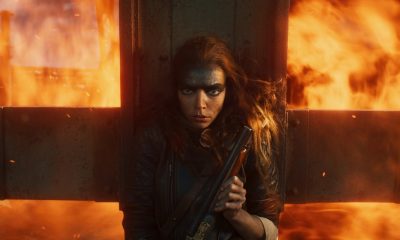Entertainment
Wildlife Photographer of the Year top photos show nature at its most beautiful and harrowing

If the “highly commended” images look this stunning, imagine what the winning images will look like.
As is their annual tradition, London’s National History Museum has unveiled the Wildlife Photographer of the Year competition’s highly commended entries, ahead of the winners being announced on Oct. 11.
Covering categories from Animal Portraits to Natural Artistry and ranging from the rivers of Finland to a small island in the Russian High Arctic, here are the highly commended images for 2022 (fair warning: the final few images in the series are fairly disturbing).

“The snow stag” by Joshua Cox, 10 Years and Under.
Credit: Joshua Cox
“Joshua Cox frames a red deer stag standing majestically as the snow falls,” reads the caption. “It had just started to snow when Joshua and his father arrived in Richmond Park. They followed the deer at a safe distance when suddenly the snow intensified and one of the stags stopped. ‘He almost looked as if he was having a snow shower,’ says Joshua. Richmond Park is home to herds of red and fallow deer, which have been roaming freely since 1637. The grazing deer help to manage the landscape of the park.”

“The octopus case” by Samuel Sloss, 15-17 Years.
Credit: Samuel Sloss
“Samuel Sloss is spotted by a coconut octopus, which peeks out from its clam-shell shelter,” reads the caption. “Samuel was muck diving when he noticed this octopus. He lowered the power of his strobe lamp so as not to distress it. The octopus shut the lid of the shell when Samuel approached, but then slowly opened it, revealing colours and coils. This small octopus hunts mainly shrimps, crabs, clams and small fishes. To protect its soft body when foraging on sand or mud, it hides in various objects – sometimes even coconut shells.”

“Burrow mates” by Morgan Heim, Animals in their Environment.
Credit: Morgan Heim
“Morgan Heim reveals an intimate encounter between a beetle and a rabbit,” reads the caption. “Morgan set up camera traps by the active burrows of pygmy rabbits in the Columbia Basin to observe their comings and goings. She was delighted by this moment of interaction as one of the rabbits sniffed at a stink beetle that had been sheltering in its burrow. These rabbits live in Washington state’s Columbia Basin. The Basin has become increasingly overgrazed, and parts have been cleared for crop growing. With this small, isolated population facing extinction, conservationists have intervened, boosting numbers to 150 and rising.”

“The right look” by Richard Robinson, Animal Portraits.
Credit: Richard Robinson
“Richard Robinson becomes the object of fascination for a young whale,” reads the caption. “With the whale investigating him, Richard’s main challenge was to swim far enough from the curious calf to photograph it. The encounter lasted 30 minutes, with the whale circling him, swimming off, then returning for another look. New Zealand’s population of southern right whales, known as ‘tohorā’ in Māori, were hunted to near extinction by European whalers in the 1800s, then by Soviet whalers in the 1900s. Now protected, the population has bounced back from a small group including just 13 breeding females, to more than 2,000 individuals.”

“Dipper dispute” by Heikki Nikki, Behaviour: Birds.
Credit: Heikki Nikki
“Heikki Nikki witnesses two dippers fighting over prime position,” reads the caption. “After years of visiting the river, Heikki knew every ‘dipping’ rock favoured by white-throated dippers. Picking one hidden beneath flowing water, he sat quietly on the bank. Suddenly the spot became the subject of a hotly contested argument. Poised for the action, Heikki captured the fleeting moment. Dippers use ‘dipping’ rocks as a launch pad to scout rivers before diving down to hunt mayfly and caddisfly larvae and small fish, swallowing tiny catches while submerged.”

“Treefrog pool party” by Brandon Güell, Behaviour: Amphibians and Reptiles.
Credit: Brandon Güell
“Brandon Güell wades through murky water to document a rare breeding frenzy of frogs,” reads the caption. “Plagued by mosquitoes, Brandon waded chest-deep into the murky water where a gathering of male gliding treefrogs were calling. At dawn thousands of females arrived at the pool to mate and lay their eggs on overhanging palm fronds. Here, unmated males search for females to mate with. These spectacular mass-breeding events occur in only a few remote locations, a few times a year. Each female lays around 200 eggs, creating huge egg masses. Eventually the tadpoles will drop into the water below.”

“The disappearing giraffe” by Jose Fragozo, Natural Artistry.
Credit: Jose Fragozo
“Jose Fragozo captures the contrast between the natural world and human infrastructure,” reads the caption. “Keeping his camera steady in the moving vehicle, Jose followed the giraffe. Dwarfed by the giant pillars of Kenya’s new Standard Gauge Railway, the grey blocks contrast with the unmistakable pattern of nature’s tallest land mammal. Around the world, human development increasingly encroaches on the range and habitats of animals. Though this stretch of railway running through Nairobi National Park is raised on giant columns, allowing animals access beneath, this picture is symbolic of how the space for wildlife continues to be squeezed.”

“Polar frame” by Dmitry Kokh, Animal Portraits.
Credit: Dmitry Kokh
“Dmitry Kokh shares an otherworldly encounter of polar bears taking over an abandoned settlement,” reads the caption. “When Dmitry’s boat approached the small island of Kolyuchin, in the Russian High Arctic, which had been abandoned by humans since 1992, he was surprised to spot movement in one of the houses. Binoculars revealed polar bears – over 20 in total – exploring the ghost town. Dmitry used a low-noise drone to document the surreal experience. Extremely inquisitive, polar bears will investigate abandoned structures for potential food. With climate change reducing sea ice, hunting is becoming increasingly difficult, pushing these bears closer to human settlements to scavenge.”

“Underwater wonderland” by Tiina Törmänen, Under Water.
Credit: Tiina Törmänen
“Tiina Törmänen floats through sheets of cloud-like algae in search of fish,” reads the caption. “Tiina was thrilled to meet a school of inquisitive European perch on her annual lake snorkel. During the previous three years she had only ever found dead fish. Submerged in the surreal scene, she framed the orange-finned fish flying through clouds of pink-tinged algae. Although it created a beautiful scene, excessive algal growth, a result of climate change and warming waters, can cause problems for aquatic wildlife as it uses up oxygen and blocks out sunlight.”

“Just one day’s catch” by Srikanth Mannepuri, Oceans: The Bigger Picture.
Credit: Srikanth Mannepuri
“Srikanth Mannepuri takes a sobering look at the scale of unsustainable fishing,” reads the caption. “Srikanth was shocked to see so many recently caught marlin and sailfish in a single place in one morning. To demonstrate the scale of the fish market, he used a drone to take the image from a bird’s-eye view. Sailfish and marlin are top ocean predators essential to ecosystems. Globally, 85% of fish stocks are currently overexploited by humans. Without urgent efforts to protect marine habitats and create truly sustainable fishing practices, we will soon begin to lose species forever.”

“Sloth dilemma” by Suzi Eszterhas, Urban Wildlife.
Credit: Suzi Eszterhas
“Suzi Eszterhas captures an encounter between a sloth and a dog,” reads the caption. “The brown-throated sloth had already made it across a road, but to reach the next clump of trees it needed to return to the ground and crawl. Meeting a big dog, it froze. Suzi watched fearfully but the dog, having taken part in a sloth-safety training programme with Sloth Conservation Foundation, simply sniffed it. Sloths live in trees and rarely descend to the forest floor. With increasing habitat loss and the fragmentation of the forest, they are forced on vulnerable journeys across urbanised areas to find food, suitable habitats and mates.”

“The lost floods” by Jasper Doest, Wetlands: The Bigger Picture.
Credit: Jasper Doest
“Jasper Doest provides a portrait of Lubinda Lubinda, revealing the impact of drought on the Zambezi flood plain,” reads the caption. “Lubinda Lubinda is station manager for the Zambezi River Authority. Lower water levels mean his new house (right) did not need to be built as high. Climate change and deforestation mean the Barotse people of the floodplain are subject to more frequent droughts. A diversity of wildlife is dependent on regular floods, as is the Barotse people’s way of life. The wetland provides people with fish, pasture for livestock, fertile soil, and vegetation for thatching and making household items.”

“Wanted!” By Britta Jaschinski, Photojournalism.
Credit: Britta Jaschinski
“Britta Jaschinski uses torchlight to highlight the impact of coltan mining,” reads the caption. “Glowing blue, coltan is a component of phone and laptop batteries. Here Britta surrounds it with mining tools and the remains of animals impacted by the industry, all seized by customs authorities: a gorilla skull, vertebrae and leg bone, and porcupine quills. Coltan is extracted from the riverbeds of the Democratic Republic of the Congo by poorly paid miners who hunt wild animals for food. Hunting and trading wildlife threatens the future of the country’s gorillas and has led to an increased risk of viruses jumping to humans.”

“Life and death in fur farming: by Jo-Anne McArthur, Photojournalism.
Credit: Jo-Anne McArthur
“Jo-Anne McArthur shows American mink kits fighting for space in a small cage on a fur farm,” reads the caption. “For Jo-Anne it is important to document cruelty in order to instigate change. At a Swedish mink farm, the sign above a cramped, inhospitable cage indicates two kits have died. Due to legislation changes since this photo was taken, farms now have slightly larger cages, but the standard of life remains poor. In 2020 scientists discovered that mink could catch the Covid-19 virus and that it could mutate and be transmitted to humans. In response, Denmark shut down its industry. In 2022 in Sweden, after a temporary ban on breeding, the government allowed some mink farms to reopen.”
Want more incredible Wildlife Photographer of the Year images? Here’s last year’s winners.
-

 Entertainment5 days ago
Entertainment5 days ago‘Furiosa: A Mad Max Saga’ review: George Miller’s blazing action folktale might just have outdone ‘Fury Road’
-

 Business7 days ago
Business7 days agoHealthy growth helps B2B food e-commerce startup Pepper nab $30 million led by ICONIQ Growth
-

 Entertainment6 days ago
Entertainment6 days ago‘House of the Dragon’ Season 2 trailer breakdown: Dragons, Rook’s Rest, and more
-

 Entertainment5 days ago
Entertainment5 days agoSex education is under threat in the UK. What’s going on?
-

 Business5 days ago
Business5 days agoOrange Charger thinks a $750 outlet will solve EV charging for apartment dwellers
-

 Business5 days ago
Business5 days agoSenate study proposes ‘at least’ $32B yearly for AI programs
-

 Business4 days ago
Business4 days agoColab’s collaborative tools for engineers line up $21M in new funding
-

 Business3 days ago
Business3 days agoA US Trustee wants troubled fintech Synapse to be liquidated via Chapter 7 bankruptcy, cites ‘gross mismanagement’






















